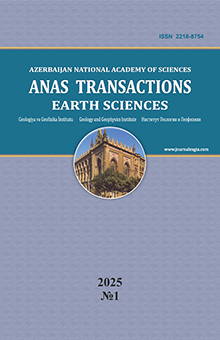The enormous Earth’s crust tension and hydrocarbon pipeline exploration in the South Caucasus – Eastern Mediterranean
Eppelbaum L.V.1,2, Katz Yu.I.3, Kadirov F.A.4,5 and Ben-Avraham Z.1
1 Dept. of Geophysics, Faculty of Exact Sciences, Tel Aviv University, Israel Ramat Aviv 6997801, Tel Aviv: levap@tauex.tau.ac.il
2 Azerbaijan State Oil and Industry University, Azerbaijan 20 Azadlig Ave., Baku, AZ1010
3 Steinhardt Museum of Natural History & National Research Center, Faculty of Life Sciences, Tel Aviv University, Ramat Aviv 6997801, Tel Aviv, Israel
4 Ministry of Science and Education of the Republic of Azerbaijan, Institute of Geology and Geophysics, Azerbaijan 119, H.Javid Ave. Baku, Az1143
5 Ministry of Science and Education of the Republic of Azerbaijan, Institute of Oil and Gas, Azerbaijan 9, F.Amirov ave., Baku, AZ 1000
Summary
The latest catastrophic earthquakes in eastern Turkey require their geodynamic understanding. The two most decisive events (with magnitude (M) = 7.8 and 7.5) were observed with an interval of 9 hours on February 06, 2023, followed by a whole series of aftershocks (four with M ≥6, about twenty-five with M ≥5 and above, and more than two hundred with M ≥4). These tragic events led to about 50 thousand deaths and enormous property damage. The above values indicate the colossal tension created in the Earth's crust. Besides the conventional geodynamic parameters, such giant tension can be caused by the influence of the giant mantle quasi-ring counterclockwise rotating structure. The existence of this structure has been detected by 11 independent geological-geophysical factors (residual satellite gravity, GPS, paleomagnetic data, geoid isolines, seismic tomography, paleobiogeographical data, coincidence of the center of the structure with the critical latitude of the Earth, a series of tectonic-structural data, etc.). The position of the western part of the Baku-Tbilisi-Ceyhan pipeline is shown on the Easternmost Mediterranean map of the satellite-derived gravity gradient field accompanied with the essential tectonic parameters. The map of the above and other pipelines of Azerbaijan is combined with the projection of the deep rotating structure on the Earth's surface. The impact of this rotation effect should be considered when laying and operating regional underground oil and gas pipelines.
Keywords: deep rotating structure, hydrocarbon pipelines, engineering geodynamics
REFERENCES
Alizadeh A.A., Guliyev I.S., Kadirov F.A., and Eppelbaum L.V. Geosciences in Azerbaijan. Volume II: Economic Minerals and Applied Geophysics. Springer. Heidelberg – N.Y., 2017, 340 p.
Eppelbaum L.V., Ben-Avraham Z., Katz Y., Cloetingh S. and Kaban M. Combined Multifactor Evidence of a Giant Lower-Mantle Ring Structure Below the Eastern Mediterranean. Positioning, Vol. 11, 2020, pp. 11-32.
Eppelbaum L.V., Ben-Avraham Z., Katz Y., Cloetingh S. and Kaban M. Giant quasi-ring mantle structure in the African-Arabian junction: Results derived from the geological-geophysical data integration. Geotectonics (Springer), Vol. 55, No. 1, 2021, pp. 67-93.
Eppelbaum L.V. and Katz Yu.I. Eastern Mediterranean: Combined geological-geophysical zonation and paleogeodynamics of the Mesozoic and Cenozoic structural-sedimentation stages. Marine and Petroleum Geol., Vol. 65, 2015, pp.198-216.
Eppelbaum L., Katz Yu., Klokochnik J., Kosteletsky J., Zheludev V. and Ben-Avraham, Z. Tectonic Insights into the Arabian-African Region Inferred from a Comprehensive Examination of Satellite Gravity Big Data. Global and Planetary Change, Vol. 171, 2018, pp. 65-87.
Faccenna C., Becker T.W., Auer L., Billi A., Boschi L., Brun J.P., Capitanio F.A., Funiciello F., Horvàth F., Jolivet L., Piromallo C., Royden L., Rossetti F. and Serpelloni E. Mantle dynamics in the Mediterranean. Review of Geophysics, Vol. 52, No. 3, 2014, pp. 283-332.
Hancilar et al. Kahramanmaraş - Gaziantep Türkiye M7.7 Earthquake, 6 February 2023. Strong Ground Motion and Building Damage Estimations. Preliminary Report. Dept. of Earthquake Engineering, Bogazici University, Turkey, 2023.
Kadirov F., Floyd M., Alizadeh A., Guliev I., Reilinger R., Kuleli S., King R., Toksoz M.N. Kinematics of the eastern Caucasus near Baku, Azerbaijan. Natural Hazards, Vol. 63, No.2, 2012, pp. 997-1006.
Reilinger R. E., McClusky S., Vernant P., Lawrence S., Ergintav S., Cakmak R., Ozener H., Kadirov F., Guliyev I. et al. GPS constraints on continental deformation in the Africa-Arabia-Eurasia continental collision zone and implications for the dynamics of plate interactions. Jour. of Geophys. Research, Vol.111, No. BO5411, 2006, pp.1-26.
Sandwell D.T. and Smith W.H.F. Global marine gravity from retracked Geosat and ERS-1 altimetry: ridge segmentation versus spreading rate. Jour. of Geophys. Research, Vol. 114, No. B01411, 2009, pp. 1-18.
Tatar O., Piper J.D.A., Gürsoy H., Heimann A. and Koşbulut F. Neotectonic deformation in the transition zone between the Dead Sea Transform and the East Anatolian Fault Zone, Southern Turkey: a palaeomagnetic study of the Karasu Rift Volcanism. Tectonophysics, Vol. 385, No. 1, 2004, pp. 17-43.
Uzel B., Langereis C.G., Kaymakci N., Sozbilir H., Ozkaymak C. and Ozkaptan M.. Paleomagnetic Evidence for an Inverse Rotation History of Western Anatolia during the Exhumation of Menderes Core Complex. Earth and Planet. Sci. Lett., Vol. 414, 2015, pp. 108-125.
Véronnet A. Rotation de l'Ellipsoide Hétérogène et Figure Exacte de la Terre. J. Math. Pures et Appl., Tome 8, Ser. 6, 1912, pp. 331-463.
DOI: 10.33677/ggianasconf20230300019
